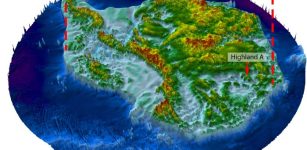Enormous Storegga Tsunami Wiped Out Communities In Stone Age Britain
Jan Bartek - AncientPages.com - Stone Age people must have been surprised and horrified when the gigantic water waves reaching 20 meters wiped out their dwellings. Some of the waves reached 20 meters, and few could survive. According to scientists, the enormous tsunami that hit Northern Europe and Britain wiped out many Stone Age communities about 8,000 years ago.
Giant tsunami waves caused a huge decline in Stone Age Britain's population. Credit: Adobe Stock - Viks_jin
A research team from the University of York has discovered there was a large population decline in northern Britain at the same time when the Storegga slide occurred between 6,225 and 6,170 B.C. The Storegga Slide is the largest known exposed submarine landslide in the world, which triggered a tsunami that inundated the coasts of northern Europe. Scientists think the number of deaths was so high that it may have led to a massive dip in Stone Age Britain's population.
Northern Britain had a small population of about 1,000 people at this time. Still, according to Dr. Jon Hill, an environmental scientist at the University of York who led the research, the tsunami caused a tragedy, and the consequences were severe.
"A giant tsunami of this size would have devastated Stone Age coastal communities as it occurred in the autumn, when they would have been gathering resources for the winter. The scale of the waves coming in would have been completely different to anything experienced by the people living there—a truly terrifying experience," Dr. Hill said.
It was previously assumed that the population decline during this period was caused by a rapid and sustained drop in temperatures across the continent, but the recent study suggests a huge tsunami should be blamed for the devastation.
"Some past fishing societies in tsunami-prone regions such as the northern Pacific have shown some resilience to tsunamis and knew about moving to higher ground. But the tsunami event in northern Britain was more of a freak event, with Stone Age people here having no living memory or ancestral knowledge about how to make themselves safe," Dr. Hill explained.
The tsunami destroyed much of the land and vital resources Stone Age people needed to survive, which led to a high mortality rate.
The dwellings of Stone Age people were destroyed when the Storegga tsunami hit. Credit: Adobe Stock - gorelovs
"Alongside the direct mortality from the waves, this tsunami created longer-term impacts on resources for Stone Age people. It would have decimated food supplies so there's a strong possibility this contributed to the sharp population decline we saw in northern Britain at this time, although this period also saw a rapid sea-level rise and a sharp drop in global temperatures," Dr. Hill said.
The locations of the Storegga slide and Storegga tsunami sediment deposits (red circles) with the run-up heights at each location indicated (produced in QGIS; based on Bateman et al, 2021). Credit: Journal of Quaternary Science (2023). DOI: 10.1002/jqs.3586
The forces of nature are powerful, and the massive tsunami took Stone Age people by surprise.
"A tsunami's sudden onset gives no warning unlike storm surges that are preceded by a period of stormy weather. Past hunter fisher gatherer societies in tsunami-prone regions such as the Northern Pacific have shown a degree of resilience to the impacts of tsunamis, mitigating effects by moving to higher ground. However, this is unlikely to have been the case for Mesolithic people in Britain where there would have been no living memory of tsunamis and no appreciation of the danger as the sea receded. Indeed, the sudden withdrawal of the sea may have attracted people to the coast to collect the exposed shellfish and other resources," the scientists write in their study.
The study was published in the Journal of Quaternary Science.
Written by Jan Bartek - AncientPages.com Staff Writer
More From Ancient Pages
-
 Evidence Of The Zanclean Megaflood In The Mediterranean Sea 5 Million Years Ago
Earth Changes | Jan 22, 2025
Evidence Of The Zanclean Megaflood In The Mediterranean Sea 5 Million Years Ago
Earth Changes | Jan 22, 2025 -
 Large Underwater Site That Was Home To 500,000 People About 14,000 Years Ago Identified Northwest Of Australia
Earth Changes | Jan 17, 2024
Large Underwater Site That Was Home To 500,000 People About 14,000 Years Ago Identified Northwest Of Australia
Earth Changes | Jan 17, 2024 -
 Younger Dryas Impact Hypothesis – New Evidence A Comet Crashed Into Earth 12,800 Years Ago
Earth Changes | Jun 1, 2024
Younger Dryas Impact Hypothesis – New Evidence A Comet Crashed Into Earth 12,800 Years Ago
Earth Changes | Jun 1, 2024 -
 Unknown Ancient World Discovered Beneath East Antarctic Ice Sheet
Earth Changes | Oct 24, 2023
Unknown Ancient World Discovered Beneath East Antarctic Ice Sheet
Earth Changes | Oct 24, 2023 -
 How Did Climate Change Impact European Ice Age Humans?
Earth Changes | Aug 21, 2024
How Did Climate Change Impact European Ice Age Humans?
Earth Changes | Aug 21, 2024 -
 How Did Homo Sapiens Survive The Magnetic North Pole Shift 41,000 Years Ago? Sunscreen, Clothes, And Caves Helped Them
Evolution | Apr 17, 2025
How Did Homo Sapiens Survive The Magnetic North Pole Shift 41,000 Years Ago? Sunscreen, Clothes, And Caves Helped Them
Evolution | Apr 17, 2025 -
 Mysterious History Of Fenland: The UK’s Possible Link To A Megadrought That Led To The Collapse Of Civilisations Around The World
Earth Changes | Nov 24, 2023
Mysterious History Of Fenland: The UK’s Possible Link To A Megadrought That Led To The Collapse Of Civilisations Around The World
Earth Changes | Nov 24, 2023 -
 How Did Prehistoric Hunter-Gatherers Cope With Climate Changes 12,000 Years Ago?
Earth Changes | Apr 4, 2025
How Did Prehistoric Hunter-Gatherers Cope With Climate Changes 12,000 Years Ago?
Earth Changes | Apr 4, 2025 -
 What Is The Link Between Drought And The ‘Barbarian Conspiracy’ In Roman Britain?
Archaeology | Apr 22, 2025
What Is The Link Between Drought And The ‘Barbarian Conspiracy’ In Roman Britain?
Archaeology | Apr 22, 2025 -
 Massive Anomaly Within Earth’s Mantle May Be Remains Of An Ancient Planet
Earth Changes | Nov 1, 2023
Massive Anomaly Within Earth’s Mantle May Be Remains Of An Ancient Planet
Earth Changes | Nov 1, 2023 -
 Surprising Time Capsule In Antarctica – Evidence Of Toxic Heavy Metal Pollution 800 Years Ago
Earth Changes | Jan 18, 2024
Surprising Time Capsule In Antarctica – Evidence Of Toxic Heavy Metal Pollution 800 Years Ago
Earth Changes | Jan 18, 2024 -
 Are Climate-Related Calamities Erasing Illinois’ Cultural History? An Archaeologist Explains
Earth Changes | Dec 27, 2024
Are Climate-Related Calamities Erasing Illinois’ Cultural History? An Archaeologist Explains
Earth Changes | Dec 27, 2024 -
 Evidence Of The Biggest Ever Solar Storm 14,300 Years Ago – Found In Ancient Tree Rings
Earth Changes | Oct 9, 2023
Evidence Of The Biggest Ever Solar Storm 14,300 Years Ago – Found In Ancient Tree Rings
Earth Changes | Oct 9, 2023 -
 Understanding The Green Sahara’s Collapse
Earth Changes | Aug 22, 2024
Understanding The Green Sahara’s Collapse
Earth Changes | Aug 22, 2024 -
 The Late Antique Little Ice Age Weakened The Roman Empire – Study Reveals
Archaeology | Apr 14, 2025
The Late Antique Little Ice Age Weakened The Roman Empire – Study Reveals
Archaeology | Apr 14, 2025 -
 Europe Was Not Covered By Dense Forest Before The Arrival Of Modern Humans
Earth Changes | Nov 17, 2023
Europe Was Not Covered By Dense Forest Before The Arrival Of Modern Humans
Earth Changes | Nov 17, 2023 -
 Geological Mystery Of The Lost Continent Argoland Solved
Earth Changes | Oct 26, 2023
Geological Mystery Of The Lost Continent Argoland Solved
Earth Changes | Oct 26, 2023



